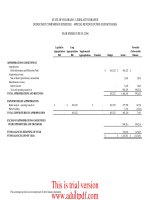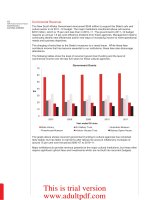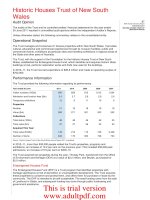LEGISLATIVE DEPARTMENT, STATE OF COLORADO FINANCIAL AUDIT REPORT YEARS ENDED JUNE 30, 2003 AND 2002_part1 ppt
Bạn đang xem bản rút gọn của tài liệu. Xem và tải ngay bản đầy đủ của tài liệu tại đây (50.54 KB, 10 trang )
LEGISLATIVE DEPARTMENT, STATE OF COLORADO
FINANCIAL AUDIT REPORT
YEARS ENDED JUNE 30, 2003 AND 2002
This is trial version
www.adultpdf.com
LEGISLATIVE AUDIT COMMITTEE
2003 MEMBERS
Senator Ron Tupa
Chairman
Representative Tambor Williams
Vice Chairman
Senator Norma Anderson
Representative Fran Coleman
Representative Pamela Rhodes
Senator Stephanie Takis
Senator Jack Taylor
Representative Val Vigil
OFFICE OF THE STATE AUDITOR
Joanne Hill
State Auditor
Sally Symanski
Deputy State Auditor
Robin Peterson
Legislative Auditor
Gelfond Hochstadt Pangburn, P.C.
Contract Auditors
This is trial version
www.adultpdf.com
LEGISLATIVE DEPARTMENT, STATE OF COLORADO
TABLE OF CONTENTS
YEARS ENDED JUNE 30, 2003 AND 2002
PAGE
Report summary 1
Description of the Legislative Department 3
Independent auditors’ report 6
Management’s discussion and analysis 8
Financial statements:
Balance sheets – governmental funds – June 30, 2003
and June 30, 2002 12
Statements of appropriations, revenues, expenditures, and changes in
fund balances – governmental funds – years ended June 30, 2003 and June 30, 2002 13
Budgetary comparison schedule – general fund (budget basis) –
year ended June 30, 2003 14
Budgetary comparison schedule – general fund (budget basis) –
year ended June 30, 2002 15
Budgetary comparison schedule – special revenue funds (budget basis) –
year ended June 30, 2003 16
Budgetary comparison schedule – special revenue funds (budget basis) –
year ended June 30, 2002 17
Notes to financial statements 18
This is trial version
www.adultpdf.com
LEGISLATIVE DEPARTMENT, STATE OF COLORADO
TABLE OF CONTENTS (CONTINUED)
YEARS ENDED JUNE 30, 2003 AND 2002
PAGE
Supplemental information:
Combining balance sheet – general fund – June 30, 2003 32
Combining balance sheet – general fund – June 30, 2002 33
Combining schedule of appropriations, revenues, expenditures, and
changes in fund balances – general fund – year ended June 30, 2003 34
Combining schedule of appropriations, revenues, expenditures, and
changes in fund balances – general fund – year ended June 30, 2002 35
Schedules of appropriations – general fund – years ended June 30, 2003 and 2002 36
Combining balance sheets – special revenue funds – years ended
June 30, 2003 and 2002 37
Combining schedules of revenues, expenditures, and changes in
fund balances – special revenue funds – years ended June 30, 2003
and June 30, 2002 38
Report on compliance and on internal control over financial reporting
based on audits of financial statements performed in accordance with
Government Auditing Standards 39
Required auditor communications to the Legislative Audit Committee 40
Distribution page 43
This is trial version
www.adultpdf.com
LEGISLATIVE DEPARTMENT, STATE OF COLORADO
REPORT SUMMARY
YEARS ENDED JUNE 30, 2003 AND 2002
1
Authority:
The authority for this audit exists in the Colorado Constitution and State statute. A contract exists by and
between the State of Colorado, through the State Auditor and the Legislative Audit Committee, and
Gelfond Hochstadt Pangburn, P.C. (“GHP” or the “Contract Auditors”), whereby the audits of the
Legislative Department, State of Colorado (the “Department”) for the Fiscal Years ended June 30, 2003
and 2002 were performed by GHP.
Standards:
The audits were conducted in accordance with auditing standards generally accepted in the United States
of America, as promulgated by the American Institute of Certified Public Accountants in Statements on
Auditing Standards, and the standards for financial audits contained in Government Auditing Standards,
issued by the Comptroller General of the United States.
Purpose and scope:
The primary purpose of the engagement was to conduct financial and compliance audits of the
Department, as of and for the Fiscal Years ended June 30, 2003 and 2002, in accordance with standards
described above. These standards require that the Contract Auditors plan and perform the audits to obtain
reasonable assurance about whether the financial statements are free of material misstatement. An audit
includes examining, on a test basis, evidence supporting the amounts and disclosures in the financial
statements. An audit also includes assessing the accounting principles used and significant estimates made
by management, as well as evaluating the overall financial statement presentation.
As part of obtaining reasonable assurance about whether the financial statements are free of material
misstatement, tests of the Department’s compliance with certain provisions of laws, regulations, and
contracts were performed, noncompliance with which could have a direct and material effect on the
determination of financial statement amounts.
Auditors’ reports:
An independent auditors’ report on the financial statements of the Department dated August 22, 2003 has
been issued, which states that the financial statements present fairly, in all material respects, the financial
position of the Department as of June 30, 2003 and 2002, and its changes in financial position for the
fiscal years then ended, in accordance with accounting principles generally accepted in the United States of
America.
A report on compliance and on internal control over financial reporting based on the audits of financial
statements performed in accordance with Government Auditing Standards dated August 22, 2003 has also
been issued, which states that the results of the Contract Auditors’ tests disclosed no instances of
noncompliance that are required to be reported under Government Auditing Standards.
This is trial version
www.adultpdf.com
LEGISLATIVE DEPARTMENT, STATE OF COLORADO
REPORT SUMMARY (CONTINUED)
YEARS ENDED JUNE 30, 2003 AND 2002
2
Required auditor communications to the Legislative Audit Committee:
The Contract Auditors are required to communicate to the Legislative Audit Committee certain matters
related to the conduct of the audits and to ensure that the Legislative Audit Committee receives additional
information regarding the scope and results of the audits that may assist the Legislative Audit Committee
in overseeing the financial reporting and disclosure process for which management is responsible. These
matters have been communicated to the Legislative Audit Committee in this report and include among
other items, that effective July 1, 2001, the Department adopted the provisions of Governmental
Accounting Standards Board Statement No. 34, Basic Financial Statements – and Management’s
Discussion and Analysis – for State and Local Governments, as amended, Statement No. 37, Basic
Financial Statements – and Management’s Discussion and Analysis – for State and Local Governments;
Omnibus, Statement No. 38, Certain Financial Statement Disclosures, Statement No. 41, Budgetary
Comparison Schedules – Perspective Differences and Interpretation No. 6, Recognition and Measurement
of Certain Liabilities and Expenditures in Governmental Fund Financial Statements. In addition, no audit
adjustments were required, and there were no difficulties encountered in performing the audits.
This is trial version
www.adultpdf.com
LEGISLATIVE DEPARTMENT, STATE OF COLORADO
DESCRIPTION OF THE LEGISLATIVE DEPARTMENT
YEARS ENDED JUNE 30, 2003 AND 2002
3
LEGISLATIVE DEPARTMENT AGENCY DESCRIPTIONS:
General Assembly:
Colorado’s State Legislature is called the General Assembly. The Colorado Constitution grants the law-
making power and thus, the public policy-making power of the State, to the General Assembly. There are
100 elected members serving as the Legislature - 35 senators and 65 representatives. As one of the three
branches of state government, the Legislature includes the elected officials of the Senate and the House of
Representatives and support staff.
A candidate for the General Assembly must be at least 25 years old, a citizen of the United States, and a
resident of the district he or she is seeking to represent for at least twelve months prior to the election.
Amendment No. 5 to the Colorado Constitution, approved by the voters at the 1990 general election,
limited the terms of office of state senators to two consecutive four-year terms, and state representatives to
four consecutive two-year terms, effective for terms beginning on or after January 1, 1991.
The Secretary of the Senate and the Chief Clerk of the House and their employees are responsible for the
daily administration of each house including the preparation of daily calendars and journals, the
preparation of floor amendments, the engrossing and enrolling procedures, the handling of messages to and
from the Governor, communications between the two houses of the Legislature, and communications to
the General Assembly from other state officers and departments, custody of documents and records of the
two houses, and the maintenance of pay records for all personnel employed by the House and Senate.
Joint Budget Committee:
The six-member Joint Budget Committee is the fiscal and budget review agency of the Colorado General
Assembly. The Committee works year-round and has a full-time staff. The Committee studies the
programs, management, operations, and fiscal needs of all state agencies. It reviews budget requests and
holds hearings with agency managers. The Committee also reviews capital construction and controlled
maintenance recommendations made by the Capital Development Committee.
This is trial version
www.adultpdf.com
LEGISLATIVE DEPARTMENT, STATE OF COLORADO
DESCRIPTION OF THE LEGISLATIVE DEPARTMENT (CONTINUED)
YEARS ENDED JUNE 30, 2003 AND 2002
4
LEGISLATIVE DEPARTMENT AGENCY DESCRIPTIONS (CONTINUED):
Joint Budget Committee (continued):
Each year, the Committee introduces supplemental appropriations bills and the general appropriations bill,
also known as the “Long Bill”. The Long Bill narrative explains the recommendations that the Committee
included in the Bill.
After each session, the Committee writes the appropriations report. This report explains legislative intent
and gives program guidance to state agencies related to the budget.
The committee members are the chairs of the House and Senate Appropriations Committees plus one
majority and one minority member from each of these committees. The Committee elects a chairman and a
vice-chairman, one from the Senate and one from the House. The elected chairman serves during the first
regular session of the General Assembly and as vice-chairman during the second session. The elected vice-
chairman serves as chairman during the second session.
Legislative Council:
The Legislative Council Committee is an eighteen-member body comprised of six members of the Senate
appointed by the President, six members of the House appointed by the Speaker subject to the approval of
their respective houses, and the six-member Executive Committee. The six-member Executive Committee
of the Legislative Council is comprised of the President of the Senate, the Speaker of the House of
Representatives and the majority and minority leaders of both houses.
The Legislative Council was created in 1953 to collect data, examine constitutional and statutory
provisions and possible amendments, consider important issues of public policy, and prepare reports, bills,
and other documents for presentation to the General Assembly.
The information-gathering function of the Legislative Council created a need for a continuing and
permanent research staff to work for the General Assembly. To fulfill this function, the Legislative
Committee hires a Director of Research who appoints professional, technical, clerical, and other employees
necessary to perform the functions assigned. The responsibilities and functions of the staff may be grouped
under six broad activities:
- Staffing interim and statutory committees
- Staffing committees of reference
- Responding to requests for research
- Preparing fiscal notes
- Providing revenue projections
- Performing other centralized support services
This is trial version
www.adultpdf.com
LEGISLATIVE DEPARTMENT, STATE OF COLORADO
DESCRIPTION OF THE LEGISLATIVE DEPARTMENT (CONTINUED)
YEARS ENDED JUNE 30, 2003 AND 2002
5
LEGISLATIVE DEPARTMENT AGENCY DESCRIPTIONS (CONTINUED):
Office of the State Auditor:
The State Auditor is appointed by a majority vote of the members of the General Assembly to serve for a
term of five years. The State Auditor must be a certified public accountant licensed in Colorado. The
duties of the State Auditor are to conduct performance and financial audits of all state departments,
institutions, and agencies of state government and to conduct special audits of any department, institution,
or agency upon the request of the Governor or the General Assembly.
The Legislative Audit Committee consists of four members from the Senate, two from each major political
party, and four members from the House, two from each major political party.
Office of Legislative Legal Services:
The Committee on Legal Services consists of ten members of the General Assembly. The Committee on
Legal Services appoints a director who is an attorney-at-law. The director appoints a professional staff
which includes attorneys-at-law and technical and clerical personnel to assist in the operation of the Office
of Legislative Legal Services.
Within the Office of Legislative Legal Services is the Revisor of Statutes. The Revisor and his staff
prepare various legal publications.
The Office of Legislative Legal Services prepares the bills, resolutions, and memorials introduced in the
General Assembly. Under joint rule, no bill may be introduced in either house unless first approved as to
form by the Office of Legislative Legal Services. In addition, many amendments and all conference
committee reports are prepared by the office.
The Office, acting under the direction of the Committee on Legal Services, coordinates litigation involving
the General Assembly. Staff attorneys assist retained counsel in the preparation of briefs and other legal
research and writing.
The Office also reviews rules and regulations promulgated by executive agencies.
Reapportionment Commission:
The Reapportionment Commission is appointed every ten years to reapportion the state legislative districts.
The Reapportionment Commission is an eleven-member body comprised of four members of the General
Assembly, three persons appointed by the Governor, and four persons appointed by the Chief Justice of the
Colorado Supreme Court.
This is trial version
www.adultpdf.com
6
INDEPENDENT AUDITORS’ REPORT
Members of the Legislative Audit Committee:
We have audited the accompanying financial statements of the governmental activities and each major fund of
the Legislative Department (the “Department”), State of Colorado (the “State”), as of and for the years ended
June 30, 2003 and 2002, as shown on pages 12 through 31. These financial statements are the responsibility of
the Department’s management. Our responsibility is to express an opinion on these financial statements based
on our audits.
We conducted our audits in accordance with auditing standards generally accepted in the United States of
America. Those standards require that we plan and perform the audits to obtain reasonable assurance about
whether the financial statements are free of material misstatement. An audit includes examining, on a test basis,
evidence supporting the amounts and disclosures in the financial statements. An audit also includes assessing
the accounting principles used and significant estimates made by management, as well as evaluating the overall
financial statement presentation. We believe that our audits provide a reasonable basis for our opinion.
In our opinion, the financial statements referred to above present fairly, in all material respects, the respective
financial position of the governmental activities and each major fund of the Department, as of June 30, 2003
and 2002, and the respective changes in financial position, thereof and the respective budgetary comparison for
the general fund and the special revenue funds for the years then ended in conformity with accounting
principles generally accepted in the United States of America.
As described in Note 4, the Department has implemented a new financial reporting model, as required by the
provisions of Governmental Accounting Standards Board Statement No. 34, Basic Financial Statements - and
Management’s Discussion and Analysis – for State and Local Governments, as amended, Statement No. 37,
Basic Financial Statements – and Management’s Discussion and Analysis – for State and Local Governments;
Omnibus, Statement No. 38, Certain Financial Statement Disclosures, Statement No. 41, Budgetary
Comparison Schedules – Perspective Differences and Interpretation No. 6, Recognition and Measurement of
Certain Liabilities and Expenditures in Governmental Fund Financial Statements, as of July 1, 2001.
Management’s discussion and analysis on pages 8 through 11 are not a required part of the basic financial
statements but are supplementary information required by accounting principles generally accepted in the
United States of America. We have applied certain limited procedures, which consisted principally of inquiries
of management regarding the methods of measurement and presentation of the required supplementary
information. However, we did not audit the information and express no opinion on it.
As discussed in Note 1, the financial statements of the Department are intended to present the financial
position and the changes in financial position of only that portion of the governmental activities and each major
fund of the State that is attributable to the transactions of the Department. They do not purport to, and do not,
present fairly the financial position of the State as of June 30, 2003 and 2002, and the changes in its financial
position and budgetary comparisons for the years then ended in conformity with accounting principles
generally accepted in the United States of America.
This is trial version
www.adultpdf.com









